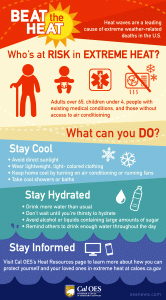

- Reduce outdoor activities in the afternoon.
- Wear light, loose-fitting clothing.
- Drink plenty of water.
- Apply sunscreen regularly.
- Know where shade is available.
- Don’t leave pets and children in cars.
- Check in on those most susceptible to heat impacts.
Additionally, be “weather aware” during these times. The National Weather Service (NWS) issues heat watches, advisories, and warnings (also referred to as “Heat Products”) to help people understand the potential health impacts a heat event may have. They also provide a HeatRisk tool to aid in planning.
Understanding NWS Heat Products:
- Heat Watch: Issued when there is potential for excessive heat, but its occurrence, location, or timing is uncertain. It indicates that a heat event is possible, so people should be prepared and stay informed.
- Heat Advisory: Issued when a heat event is occurring, imminent, or likely, causing significant inconvenience but not severe enough for a warning. Caution is needed as certain situations may threaten life or property.
- Heat Warning: Issued when an extreme heat event is happening or imminent and poses a significant threat to life or property. Immediate precautions are necessary.
NWS HeatRisk Tool
The NWS HeatRisk is an experimental color-numeric-based index that provides a forecast risk of heat-related impacts over a 24-hour period. HeatRisk takes into consideration:
- How unusual the heat is for the time of the year.
- The duration of the heat, including both daytime and nighttime temperatures.
- If those temperatures pose an elevated risk of heat-related impacts based on data from the CDC.
This index is supplementary to official NWS heat products and provides risk guidance for heat-sensitive populations.
Energy Conservation During Heat Events
Occasionally, due to predictions of high heat and energy demand, the California Independent System Operator (CAISO) may issue a statewide Flex Alert during heat events and call for voluntary electricity conservation for a certain amount of time. Visit CAISO’s web page for information about California’s electric grid and to view usage and to sign up for Flex Alerts. If a Flex Alert is called, the best ways to conserve energy are:
- Raise the thermostat: Set to 78 degrees when at home, health permitting. Turn it up to 85 degrees or off when not at home.
- Use a ceiling fan: This will allow you to raise the thermostat about 4 degrees to save on cooling costs with no reduction to comfort.
- Turn off fans and lights when you leave a room.
- Cover windows: Use shade coverings and awnings so the A/C won’t have to work as hard.
- Avoid using the oven: Instead, cook on the stove, use a microwave, or grill outside.
- Limit the opening of your refrigerator: The average fridge is opened 33 times a day – how low can you go?
- Charge electric cars after 9 or 10 pm.
Additional Resources
If you don’t have air conditioning, the Sonoma Valley Library, located at 755 West Napa St, is open 7 days a week and can provide a cool place to stay during a heat event.
Find more tips, resources, and information about how you can better prepare for excessive heat:
